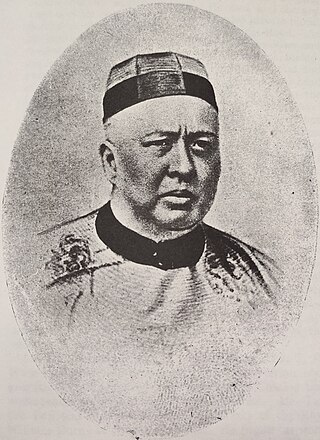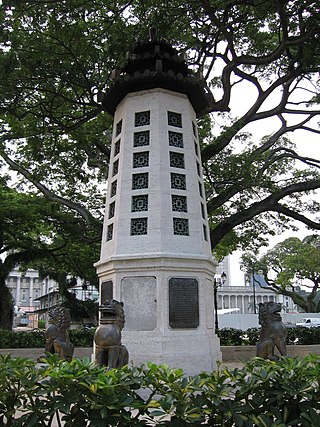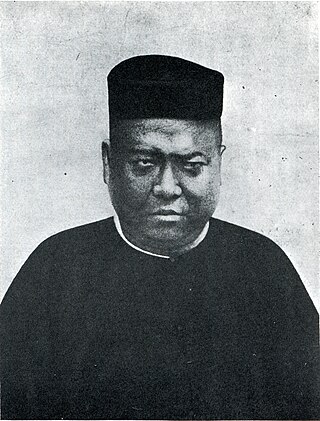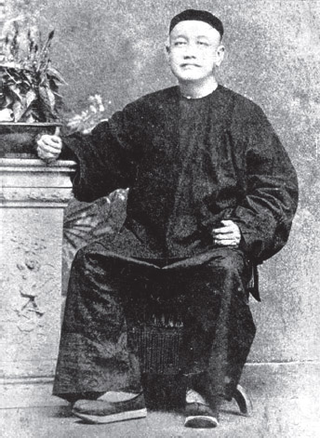Related Research Articles
The Most Honourable Order of the Crown of Johor is an Order of chivalry awarded by the Sultan of Johor. It was first instituted on July 31, 1886.

Seah Eu Chin was an immigrant from South China to Singapore, later becoming a successful merchant, a prominent descendant of Seah Clan and leader in the Overseas Chinese community.

Singapore Chinese Girls' School (SCGS) is an independent girls' school in Bukit Timah, Singapore, located opposite Stevens MRT station. Founded in 1899, it is one of the oldest institutions in Singapore. It offers a six-year primary education in its primary school section, as well as a four-year secondary education in its secondary school section, which was among the first secondary schools in Singapore to be accorded independent school status in 1989. Since 2013, it has partnered with Eunoia Junior College for a six-year Integrated Programme, which allows its secondary school students to proceed to Eunoia for Years 5 and 6 and take the Singapore-Cambridge GCE Advanced Level examinations at the end of Year 6.

Lim Boon Keng was a Peranakan physician who advocated social and educational reforms in Singapore in the early 20th-century. He also served as the president of Xiamen University in China between 1921 and 1937.

The Istana Park is a park in Singapore, located in the Museum Planning Area within the Central Area, Singapore's central business district. The park is bounded by Orchard Road, Penang Road, Penang Lane and Buyong Road.

Seow Poh Leng one of the first few Peranakan Babas at Emerald Hill, was a prominent and successful Singaporean banker, founding member of the Ho Hong Bank, member of the committee of the Straits Settlement, philanthropist and benefactor of public development works. He was a strong advocate of limited liability trading and promoted the advantages of the Limited Liability Company system.

Tan Kim Ching, also known as Tan Kim Cheng, was a Chinese politician and businessman. He was the eldest of the three sons of Tan Tock Seng, the founder and financier of Tan Tock Seng Hospital. He was consul for Japan, Thailand and Russia, and was a member of the Royal Court of Siam. He was one of Singapore's leading Chinese merchants and was one of its richest men in Singapore at that time. He was also the first Asian member of the Straits Branch of the Royal Asiatic Society. After his father's death, he became the Kapitan Cina of the Straits Chinese community. He is believed to have been the head of the Triad in Malaya.

The Lim Bo Seng Memorial is an octagonal pagoda-like war memorial at Esplanade Park, Singapore. It was erected in 1954 in honour of the late Lim Bo Seng for his heroic acts and selfless sacrifice during the World War II. The war memorial is the only structure in Singapore that commemorates an individual's efforts in World War II and was gazetted as a national monument on 28 December 2010.
Gan Eng Seng was a Chinese businessman and philanthropist who was one of the early pioneers of Singapore. He is known for his generosity to many charitable causes in Malaya and Singapore during the British colonial era. Some of his most recognised contributions were the setting up of Gan Eng Seng School, the Thong Chai Medical Institution, Tan Tock Seng Hospital, and the Ee Hoe Hean Club.

Tan Boo Liat was a wealthy Singapore philanthropist. He was the son of Tan Soon Toh, grandson of Tan Kim Ching and great-grandson of Tan Tock Seng.

Lim Ho Puah was a Hokkien merchant who was born in Amoy in 30 December 1841 and came to Singapore at an early age. He was employed by Wee Bin & Co., where his abilities were noticed by his employer, Wee Bin. He later married Wee Bin's daughter. He was the founder and senior partner of the Wee Bin Steamship Line and other concerns.

Wee Boon Teck was the only son of Wee Bin and was the latter's successor at the firm of Wee Bin & Co., where he improved and strengthened the position of the firm. He served on the committees of Tan Tock Seng Hospital and Po Leung Kuk. He donated $4,000 to the Tan Tock Seng Hospital, which was invested by Government for about twenty years and which was then applied towards the cost of building a ward bearing his name in the Hospital at Moulmein Road. He was described as having a kindly and charitable disposition. Wee Boon Teck died on 22 September 1888 at the age of 38. Boon Teck Road is named after him.

Kapitan China Lim Ah Siang, a timber merchant and steam saw miller, the founder of "Chop Sin Moh" Johor Bahru, was the third leader of the Ngee Heng Kongsi of Johor, a legitimised secret society based in Johor Bahru. He was appointed to the position not because he was the most prominent Chinese in Johor at the time but rather, because he was not.

Cheang Hong Lim JP was a Chinese opium merchant and philanthropist in Singapore. He was recognised by the British colonial administration as head of the local Hokkien Chinese community.

Tan Jiak Kim CMG was a Peranakan merchant, political activist and philanthropist from Singapore. He co-founded the Straits Chinese British Association along with Lim Boon Keng, Seah Liang Seah and Song Ong Siang.
The Chinese Commercial Bank was a Malayan bank established in Singapore in 1912. It was also the first Hokkien bank in Singapore. In 1932, the bank was merged with Ho Hong Bank and Oversea-Chinese Bank to form the Oversea-Chinese Banking Corporation.
Goh Siew Tin, alias Goh Tat Pang, was a prominent Chinese merchant. He was the first president of the Singapore Chinese Chamber of Commerce, and was known as the founder of Batu Pahat, Johor.
Yin Suat Chuan was a physician, the first president of the Straits Chinese Football Association, a member of the Municipal Commission of Singapore and a prominent figure of the anti-opium movement in Singapore.
References
- 1 2 3 4 Tan, Gia Lim (2018). An Introduction to the Culture and History of the Teochews in Singapore. World Scientific. p. 122. ISBN 9813239352.
- 1 2 3 Chong, Guang Kwa; Bak, Lim Kua (2019). A General History Of The Chinese In Singapore. World Scientific. p. 864. ISBN 9813277653.
- 1 2 3 4 5 Song, Ong Siang (1923). One Hundred Years' History of the Chinese in Singapore. J. Murray. p. 131-4.
- ↑ Song, Ong Siang (1923). One Hundred Years' History of the Chinese in Singapore. J. Murray. p. 155.
- 1 2 Song, Ong Siang (1923). One Hundred Years' History of the Chinese in Singapore. J. Murray. p. 202.
- ↑ "Seng Poh Road, 1992 : general view [3] | PictureSG". eresources.nlb.gov.sg. Retrieved 2022-06-20.
- ↑ "Seng Poh Lane, HDB flats : panoramic view | PictureSG". eresources.nlb.gov.sg. Retrieved 2022-06-20.